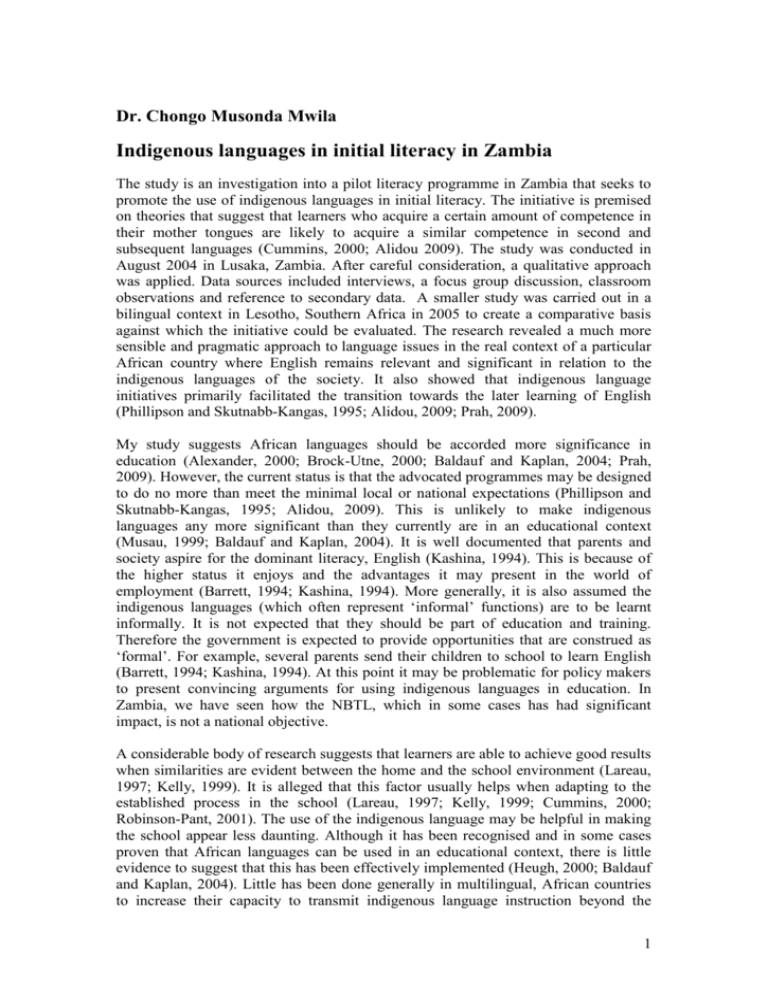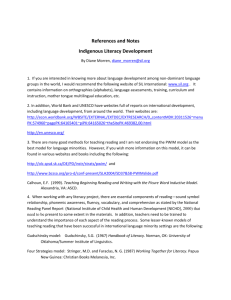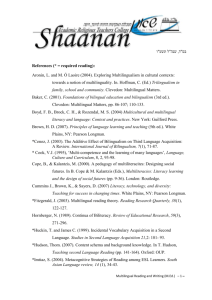Indigenous languages in initial literacy in Zambia
advertisement

Dr. Chongo Musonda Mwila Indigenous languages in initial literacy in Zambia The study is an investigation into a pilot literacy programme in Zambia that seeks to promote the use of indigenous languages in initial literacy. The initiative is premised on theories that suggest that learners who acquire a certain amount of competence in their mother tongues are likely to acquire a similar competence in second and subsequent languages (Cummins, 2000; Alidou 2009). The study was conducted in August 2004 in Lusaka, Zambia. After careful consideration, a qualitative approach was applied. Data sources included interviews, a focus group discussion, classroom observations and reference to secondary data. A smaller study was carried out in a bilingual context in Lesotho, Southern Africa in 2005 to create a comparative basis against which the initiative could be evaluated. The research revealed a much more sensible and pragmatic approach to language issues in the real context of a particular African country where English remains relevant and significant in relation to the indigenous languages of the society. It also showed that indigenous language initiatives primarily facilitated the transition towards the later learning of English (Phillipson and Skutnabb-Kangas, 1995; Alidou, 2009; Prah, 2009). My study suggests African languages should be accorded more significance in education (Alexander, 2000; Brock-Utne, 2000; Baldauf and Kaplan, 2004; Prah, 2009). However, the current status is that the advocated programmes may be designed to do no more than meet the minimal local or national expectations (Phillipson and Skutnabb-Kangas, 1995; Alidou, 2009). This is unlikely to make indigenous languages any more significant than they currently are in an educational context (Musau, 1999; Baldauf and Kaplan, 2004). It is well documented that parents and society aspire for the dominant literacy, English (Kashina, 1994). This is because of the higher status it enjoys and the advantages it may present in the world of employment (Barrett, 1994; Kashina, 1994). More generally, it is also assumed the indigenous languages (which often represent ‘informal’ functions) are to be learnt informally. It is not expected that they should be part of education and training. Therefore the government is expected to provide opportunities that are construed as ‘formal’. For example, several parents send their children to school to learn English (Barrett, 1994; Kashina, 1994). At this point it may be problematic for policy makers to present convincing arguments for using indigenous languages in education. In Zambia, we have seen how the NBTL, which in some cases has had significant impact, is not a national objective. A considerable body of research suggests that learners are able to achieve good results when similarities are evident between the home and the school environment (Lareau, 1997; Kelly, 1999). It is alleged that this factor usually helps when adapting to the established process in the school (Lareau, 1997; Kelly, 1999; Cummins, 2000; Robinson-Pant, 2001). The use of the indigenous language may be helpful in making the school appear less daunting. Although it has been recognised and in some cases proven that African languages can be used in an educational context, there is little evidence to suggest that this has been effectively implemented (Heugh, 2000; Baldauf and Kaplan, 2004). Little has been done generally in multilingual, African countries to increase their capacity to transmit indigenous language instruction beyond the 1 primary years (Alexander, 2000; Heugh, 2000; Baldauf and Kaplan, 2004; Alidou, 2009; Prah, 2009). In Zambia, the use of English has often been blamed by policy makers for the decline in literacy levels (Kelly, 1999; Linehan, 1999). In this particular study what was evident was context of the classroom. The flexibility in language use (teacher reverting to the indigenous language to aid understanding) does not, however, suggest that this is a bilingual programme. What we see here is what is commonly referred to as the free use of two or more languages (Oskaar, 1971, cited in Skutnabb-Kangas, 1981). Bilingual education involves promoting levels of functionality and competence (Skutnabb-Kangas, 1981; Cummins, 2000; Herdina and Jessner, 2002). This would then support the argument that bilingualism might have positive effects on linguistic and cognitive development (Cummins, 2000, BrockUtne, 2000; Alidou, 2009). However, this is highly dependent on providing the appropriate conditions (Cummins, 2000). In this context, the availability of opportunities to develop bilingual literacy can be contested. This is because indigenous languages are confined to initial literacy and the two or three year programmes end abruptly (Linehan,1999). Therefore, the NBTL like similar bilingual programmes in several African countries may be seen as a transition programme (Phillipson and Skutnabb-Kangas, 1995; Alidou, 2009). Some western definitions may be largely insignificant in relation to practical realities in the Sub-Saharan context (Rassool, 2007). To be effective, one needs to be able to participate in activities with the different social groups one experiences. These experiences are more meaningful than the belief that everyone has a function in the ‘global arena’. Some of the facts outlined in this study should serve as a source of encouragement. Indigenous language initiatives should be developed and availed to the majority (Hornberger, 1993; Brisk, 1998). This may be even more pertinent in the context of ‘new literacies’, which concern themselves with social practices in a sociocultural context (Gee, 1996; Street, 2001; Herbert and Robinson, 2001). Indeed, very few Africans can conceive of their direct participation in a global world. In Zambia, our aim should be to strive to make effective use of our indigenous languages through purposive literacy interventions (Alexander, 2000; Brock-Utne, 2000; Alidou, 2009; Prah, 2009). Citizens should be empowered with skills that will allow them to survive in the ‘real world’, which to many is and can only be Zambia. Political will should be reflected in the adoption of meaningful educational policies (Baldauf and Kaplan, 2004). In this and other similar contexts, emphasis should be on what is relevant and necessary. In particular, the focus should be on skills that enable the citizens to participate and survive locally (Street, 2001; Egbo, 2004). I have emphasised how the success of the NBTL was most evident in the learning environment. What was evident was the reflection of elements of a transformative pedagogy (Armour, 2001). Children were demonstrating critical thinking through practical action. For instance, the focus on group work revealed that the learners are developing leadership skills through the opportunities provided. They co-operated and collaborated, independent of the teacher who remained focussed on the teacher centred activity. The new methodology (child centred approach) is significant in this regard. These practices in initial literacy created an enabling environment spurred by active participation (Armour, 2001). This is largely because the children understood and were able to apply the local language in use. The issue here is not what standards of literacy are appropriate for which 2 communities but what is significant and relevant in different contexts (Street, 2001; Egbo, 2004). Therefore, these skills enabled the learners to participate in the teaching and learning activities I observed. In Zambia, the language policy has not been changed and English remains the official language of instruction. Teachers are encouraged to use their flexibility to aid comprehension and communication. In such instances it is left to the individual schools to opt for whatever practice they find beneficial. A proposed change in national language policy is, however, unlikely in this context. This is because several reasons advanced for the choice of language policy after the attainment of political independence in 1964 may still be valid today. Therefore the realistic expectation in this situation is that English will continue as the medium of instruction and the dominant literacy as dictated by global perspectives (Pennycook, 1998; Rassool, 1999). This is also supported by the argument that indigenous languages are not effectively developed to be used in further education (Phillipson and SkutnabbKangas, 1995; Baldauf and Kaplan, 2004). References ALEXANDER, N., 2000. Language policy and planning in South Africa: some insights. In: R. PHILLIPSON, ed. Rights to language equity, power and education: celebrating the 60th birthday of Tove Skuttnabb-Kangas. New York and London: Lawrence Erlbaum Associates Publishers, pp. 170-173. ALIDOU, H., 2009. Promoting multilingual and multicultural education in Francophone Africa: challenges and perspectives: In B. BROCK-UTNE AND I. SKATTUM, eds. Languages and education in Africa: a comparative and transdisciplinary analysis. Didcot, UK: Symposium Books, pp. 105-131. ARMOUR, W. S., 2001. This guy is Japanese stuck in a white man’s body: a discussion of meaning making identity slippage and cross cultural adaptation. Journal of multilingual and multicultural development, 22(1), pp. 1-18. BALDAUF, R.B., JR. AND KAPLAN, R.B., eds., 2004 Language planning and policy in Africa: Botswana, Malawi, Mozambique and South Africa: Vol.1. Clevedon, UK: Multilingual Matters. BARRETT, J., 1994. Why is English still the medium of education in Tanzanian secondary schools? Journal of language, culture and curriculum, 7 (1), pp. 3-16. BRISK, M.E., 1998. Bilingual education: from compensatory to quality schooling. New York and London: Lawrence Erlbaum Associates Publishers. BROCK-UTNE, B., 2000. Education for all-in whose language. In: R. PHILLIPSON, ed. Rights to language equity, power and education: celebrating the 60th birthday of Tove Skuttnabb-Kangas. Mahwah, NJ and London: Lawrence Erlbaum Associates Publishers, pp. 239-242. CUMMINS, J., 2000. Language, power and pedagogy: bilingual children in the crossfire. Clevedon, UK: Multilingual Matters Ltd. 3 EGBO, B., 2004. Intersections of literacy and construction of social identities. In: A. BLACKLEDGE AND A. PAVLENKO, eds. Negotiations of multiple identities in multilingual contexts. Clevedon, UK: Multilingual Matters, pp. 243-265. GEE, J.P., 1996. Social linguistics and literacies: ideology in discourses. 2nd ed. New York and London: Routledge Falmer. HERBERT, P. AND ROBINSON, C., 2001. Another language another literacy: practices in Northern Ghana. In: B.V. STREET, ed. Literacy and development: ethnographic perspectives. London: Routledge, pp. 121-136. HERDINA, P. AND JESSNER, U., 2002. A dynamic model of multilingualism: perspectives of change in psycholinguistics. Clevedon, UK: Multilingual Matters. HEUGH, K., 2000. Giving good weight to multilingualism in South Africa. In: R. PHILLIPSON, ed. Rights to language equity, power and education: celebrating the 60th birthday of Tove Skuttnabb-Kangas. Mahwah, NJ and London: Lawrence Erlbaum Associates Publishers, pp. 234-238. HORNBERGER, N.H., ed., 2003. Continua of biliteracy: an ecological framework for educational policy, research and practice in multilingual settings. Clevedon: Multilingual Matters. KASHINA, K., 1994. The dilemma of standard English in Zambia: pedagogical, educational and sociocultural considerations. Journal of language, culture and curriculum, 7(1), pp. 17-29. KELLY, M.J., 1999. Reading comes first: primary reading programme baseline reading study. Lusaka: Ministry of Education, DfID. LAREAU, A., 1997. Social class differences in family school relationships: the importance of cultural capital. In: P. BROWN, A.H. HALSEY, H. LAUDER, AND S. WELLS, eds. Education: culture, economy and society. Oxford: Oxford University Press, pp. 703-735. LINEHAN, S., 1999. Language of instruction and the quality of basic education in Zambia: A paper for UNESCO. Lusaka: DfID. MUSAU, P.M., 1999. Constraints on the acquisition planning of indigenous African languages: the case of Kiswahili in Kenya. Language, culture and curriculum, 12(2), pp. 117-126. PENNYCOOK, A., 1998. English and the discourses of colonialism. London and New York: Routledge. PHILLIPSON, R. AND SKUTNABB-KANGAS, T., eds., 1995. Linguistic human rights overcoming linguistic discrimination. Berlin: Mouton de Gruyter. 4 PRAH, K.K., 2009. Mother-tongue education in Africa for emancipation and development: towards the intellectualisation of African languages. In: B. BROCKUTNE AND I. SKATTUM, eds. Languages and education in Africa: a comparative and transdisciplinary analysis. Didcot, UK: Symposium Books, pp. 83-104. RASSOOL, N., 1999. Literacy for sustainable development in the age of information. Clevedon, UK: Multilingual Matters Ltd. RASSOOL, N., 2007. Global issues in language, education and development: perspectives from postcolonial countries. Clevedon, UK: Multilingual Matters Ltd. ROBINSON-PANT, A., 2001. Women’s literacy and health. In: B.V. STREET, ed. Literacy and development: ethnographic perspectives. London: Routledge, pp. 152170. SKUTNABB-KANGAS, T., 1981. Bilingualism or not: the education of minorities. Translated by L. Malmberg and D. Crane. Clevedon, UK: Multilingual Matters Ltd. STREET, B.V., 2001. Literacy events and literacy practices: theory and practice in the new literacy studies. In: K. Jones and M. Martin-Jones, eds. Multilingual literacies. Amsterdam: John Benjamins Publishing Company, pp. 17-29. Email address:mwilabavin5@gmail.com 5








